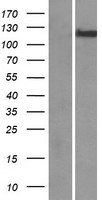order histories, retained contact details for faster checkout, review submissions, and special promotions.
Forgot password?
order histories, retained contact details for faster checkout, review submissions, and special promotions.
Locations
Orders Processing,
Shipping & Receiving,
Warehouse
2 Shaker Rd Suites
B001/B101
Shirley, MA 01464
Production Lab
Floor 6, Suite 620
20700 44th Avenue W
Lynnwood, WA 98036
Telephone Numbers
Tel: +1 (206) 374-1102
Fax: +1 (206) 577-4565
Contact Us
Additional Contact Details
order histories, retained contact details for faster checkout, review submissions, and special promotions.
Forgot password?
order histories, retained contact details for faster checkout, review submissions, and special promotions.
MLXIPL / CHREBP
MLX interacting protein-like
MLXIPL / CHREBP is a basic helix-loop-helix leucine zipper transcription factor of the Myc/Max/Mad superfamily. This protein forms a heterodimeric complex and binds and activates, in a glucose-dependent manner, carbohydrate response element (ChoRE) motifs in the promoters of triglyceride synthesis genes. The gene is deleted in Williams-Beuren syndrome, a multisystem developmental disorder caused by the deletion of contiguous genes at chromosome 7q11.23.
| Gene Name: | MLX interacting protein-like |
| Synonyms: | MLXIPL, CHREBP, MIO, MLX interactor, MLX interacting protein-like, MLX-interacting protein-like, MONDOB, WBSCR14, WS-bHLH, BHLHd14 |
| Target Sequences: | AF056184 AAD28084.1 Q9NP71 |
Publications (33)



If you do not find the reagent or information you require, please contact Customer.Support@LSBio.com to inquire about additional products in development.









